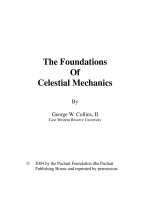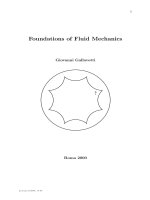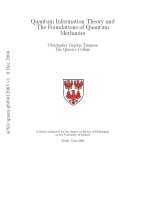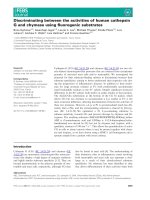- Trang chủ >>
- Khoa Học Tự Nhiên >>
- Vật lý
The foundations of celestial mechanics g w collins
Bạn đang xem bản rút gọn của tài liệu. Xem và tải ngay bản đầy đủ của tài liệu tại đây (1.59 MB, 163 trang )
The Foundations
Of
Celestial Mechanics
By
George W. Collins, II
Case Western Reserve University
© 2004 by the Pachart Foundation dba Pachart
Publishing House and reprinted by permission.
ii
To C.M.Huffer, who taught it the old way,
but who cared that we learn.
iii
iv
Table of Contents
List of Figures…………………………………………………… ………….viii
Preface………………………………………………………………………… ix
Preface to the WEB edition…………………………………………………….xii
Chapter 1: Introduction and Mathematics Review …………………………… 1
1.1 The Nature of Celestial Mechanics……………………………… 1
1.2 Scalars, Vectors, Tensors, Matrices and Their Products…………. 2
a. Scalars. ……………………………………………………… 2
b. Vectors …………………………………… …………………3
c. Tensors and Matrices…………………………………………. 4
1.3 Commutatively, Associativity, and Distributivity….……………….8
1.4 Operators…………………………………… ………………… 8
a. Common Del Operators…………………………………… 13
Chapter l Exercises…………………………………………………… 14
Chapter 2: Coordinate Systems and Coordinate Transformations………………15
2.1 Orthogonal Coordinate Systems…………………………………….16
2.2 Astronomical Coordinate Systems………………………………… 17
a. The Right Ascension –Declination Coordinate System………17
b. Ecliptic Coordinates………………………………………… 19
c. Alt-Azimuth Coordinate System…………………………… 19
2.3 Geographic Coordinate Systems…………………………………….20
a. The Astronomical Coordinate System……………………… 20
b. The Geodetic Coordinate System…………………………… 20
c. The Geocentric Coordinate System………………………… 21
2.4 Coordinate Transformations…………………………………………21
2.5 The Eulerian Angles…………………………………………………27
2.6 The Astronomical Triangle………………………………………… 28
2.7 Time………………………………………………………………….34
Chapter 2 Exercises………………………………………………………38
Chapter 3: The Basics of Classical Mechanics………………………………… 39
3.1 Newton's Laws and the Conservation of Momentum and Energy… 39
3.2 Virtual Work, D'Alembert's Principle, and Lagrange's Equations of
Motion. …………………………………………………………… 42
3.3 The Hamiltonian………………………… ……………………… 47
Chapter 3 :Exercises …………………………………………………….50
v
Chapter 4: Potential Theory…………………………………………………… 51
4.1 The Scalar Potential Field and the Gravitational Field………………52
4.2 Poisson's and Laplace's Equations………………………………… 53
4.3 Multipole Expansion of the Potential……………………………… 56
Chapter 4 :Exercises…………………………………………………… 60
Chapter 5: Motion under the Influence of a Central Force…………………… 61
5.1 Symmetry, Conservation Laws, the Lagrangian, and
Hamiltonian for Central Forces…………………………………… 62
5.2 The Areal Velocity and Kepler's Second Law………………………64
5.3 The Solution of the Equations of Motion……………………………65
5.4 The Orbit Equation and Its Solution for the Gravitational Force……68
Chapter 5 :Exercises…………………………………………………… 70
Chapter 6: The Two Body Problem…………………………………………… 71
6.1 The Basic Properties of Rigid Bodies……………………………… 71
a. The Center of Mass and the Center of Gravity……………… 72
b. The Angular Momentum and Kinetic Energy about the
Center of Mass……………………………………………… 73
c. The Principal Axis Transformation……………………………74
6.2 The Solution of the Classical Two Body Problem………………… 76
a. The Equations of Motion…………………………………… 76
b. Location of the Two Bodies in Space and Time………………78
c. The Solution of Kepler's Equation…………………………….84
6.3 The Orientation of the Orbit and the Orbital Elements………………85
6.4 The Location of the Object in the Sky……………………………….88
Chapter 6 :Exercises…………………………………………………… 91
Chapter 7: The Determination of Orbits from Observation…………………… 93
7.1 Newtonian Initial Conditions……………………………………… 94
7.2 Determination of Orbital Parameters from Angular Positions Alone. 97
a. The Geometrical Method of Kepler………………………… 98
b. The Method of Laplace………………………………………100
c. The Method of Gauss……………………………………… 103
7.3 Degeneracy and Indeterminacy of the Orbital Elements………… 107
Chapter 7 : Exercises………………………………………………… 109
vi
Chapter 8: The Dynamics Of More Than Two Bodies…………………………111
8.1 The Restricted Three Body Problem……………………………… 111
a. Jacobi's Integral of the Motion……………………………….113
b. Zero Velocity Surfaces………………………………………115
c. The Lagrange Points and Equilibrium……………………….117
8.2 The N-Body Problem……………………………………………….119
a. The Virial Theorem………………………………………… 121
b. The Ergodic Theorem……………………………………… 123
c Liouvi lle ' s Theorem……………………………………….124
8.3 Chaotic Dynamics in Celestial Mechanics…………………………125
Chapter 8 : Exercises………………………………………………… 128
Chapter 9: Perturbation Theory and Celestial Mechanics…………………… 129
9.1 The Basic Approach to the Perturbed Two Body Problem……… 130
9.2 The Cartesian Formulation, Lagrangian Brackets, and Specific
Formulae……………………………………………………………133
Chapter 9 : Exercises………………………………………………… 140
References and Supplementary Reading……………………………………….141
Index……………………………………………………………………………145
vii
List of Figures
Figure 1.1 Divergence of a vector field…………………… ……………… 9
Figure 1.2 Curl of a vector field……………………………… ………… 10
Figure 1.3 Gradient of the scalar dot-density in the form of a number of
vectors at randomly chosen points in the scalar field…….…………11
Figure 2.1 Two coordinate frames related by the transformation angles ϕ
i j
… 23
Figure 2.2 The three successive rotational transformations corresponding .
to the three Euler Angles (φ,θ,ψ)… ……………………………….27
Figure 2.3 The Astronomical Triangle………………………………………… 31
Figure 4.1 The arrangement of two unequal masses for the .
calculation of the multipole potential……………………………… 58
Figure 6.1 Geometrical relationships between the elliptic orbit and the osculating .
circle used in the derivation of Kepler's Equation……………………81
Figure 6.2 Coordinate frames that define the orbital elements………………… 87
Figure 7.1 Orbital motion of a planet and the earth moving from an initial position
with respect to the sun (opposition) to a position that repeats the .
initial alignment……………………………………………………….98
Figure 7.2 Position of the earth at the beginning and end of one sidereal period of
planet P. …………………………………………………………… 99
Figure 7.3 An object is observed at three points Pi in itsorbit and the three .
heliocentric radius vectors r
pi
………………………………………106
Figure 8.1 The zero velocity surfaces for sections through the rotating coordinate.
system…………………………………… ……………………… 116
viii
Preface
This book resulted largely from an accident. I was faced with teaching
celestial mechanics at The Ohio State University during the Winter Quarter of
1988. As a result of a variety of errors, no textbook would be available to the
students until very late in the quarter at the earliest. Since my approach to the
subject has generally been non-traditional, a textbook would have been of
marginal utility in any event, so I decided to write up what I would be teaching
so that the students would have something to review beside lecture notes. This is
the result.
Celestial mechanics is a course that is fast disappearing from the curricula
of astronomy departments across the country. The pressure to present the new
and exciting discoveries of the past quarter century has led to the demise of a
number of traditional subjects. In point of fact, very few astronomers are
involved in traditional celestial mechanics. Indeed, I doubt if many could
determine the orbital elements of a passing comet and predict its future path
based on three positional measurements without a good deal of study. This was a
classical problem in celestial mechanics at the turn of this century and any
astronomer worth his degree would have had little difficulty solving it. Times, as
well as disciplines, change and I would be among the first to recommend the
deletion from the college curriculum of the traditional course in celestial
mechanics such as the one I had twenty five years ago.
There are, however, many aspects of celestial mechanics that are common
to other disciplines of science. A knowledge of the mathematics of coordinate
transformations will serve well any astronomer, whether observer or theoretician.
The classical mechanics of Lagrange and Hamilton will prove useful to anyone
who must sometime in a career analyze the dynamical motion of a planet, star, or
galaxy. It can also be used to arrive at the equations of motion for objects in the
solar system. The fundamental constraints on the N-body problem should be
familiar to anyone who would hope to understand the dynamics of stellar
systems. And perturbation theory is one of the most widely used tools in
theoretical physics. The fact that it is more successful in quantum mechanics than
in celestial mechanics speaks more to the relative intrinsic difficulty of the
theories than to the methods. Thus celestial mechanics can be used as a vehicle to
introduce students to a whole host of subjects that they should know. I feel that
ix
this is perhaps the appropriate role for the contemporary study of celestial
mechanics at the undergraduate level.
This is not to imply that there are no interesting problems left in celestial
mechanics. There still exists no satisfactory explanation for the Kirkwood Gaps
of the asteroid belt. The ring system of Saturn is still far from understood. The
theory of the motion of the moon may give us clues as to the origin of the moon,
but the issue is still far from resolved. Unsolved problems are simply too hard for
solutions to be found by any who do not devote a great deal of time and effort to
them. An introductory course cannot hope to prepare students adequately to
tackle these problems. In addition, many of the traditional approaches to
problems were developed to minimize computation by accepting only
approximate solutions. These approaches are truly fossils of interest only to those
who study the development and history of science. The computational power
available to the contemporary scientist enables a more straightforward, though
perhaps less elegant, solution to many of the traditional problems of celestial
mechanics. A student interested in the contemporary approach to such problems
would be well advised to obtain a through grounding in the numerical solution of
differential equations before approaching these problems of celestial mechanics.
I have mentioned a number of areas of mathematics and physics that bear
on the study of celestial mechanics and suggested that it can provide examples
for the application of these techniques to practical problems. I have attempted to
supply only an introduction to these subjects. The reader should not be
disappointed that these subjects are not covered completely and with full rigor as
this was not my intention. Hopefully, his or her appetite will be 'whetted' to learn
more as each constitutes a significant course of study in and of itself. I hope that
the reader will find some unity in the application of so many diverse fields of
study to a single subject, for that is the nature of the study of physical science. In
addition, I can only hope that some useful understanding relating to celestial
mechanics will also be conveyed. In the unlikely event that some students will be
called upon someday to determine the ephemeris of a comet or planet, I can only
hope that they will at least know how to proceed.
As is generally the case with any book, many besides the author take part
in generating the final product. Let me thank Peter Stoycheff and Jason
Weisgerber for their professional rendering of my pathetic drawings and Ryland
Truax for reading the manuscript. In addition, Jason Weisgerber carefully proof
read the final copy of the manuscript finding numerous errors that evaded my
impatient eyes. Special thanks are due Elizabeth Roemer of the Steward
Observatory for carefully reading the manuscript and catching a large number of
x
embarrassing errors and generally improving the result. Those errors that remain
are clearly my responsibility and I sincerely hope that they are not too numerous
and distracting.
George W. Collins, II
June 24, 1988
xi
Preface to the WEB Edition
It is with some hesitation that I have proceeded to include this book with
those I have previously put on the WEB for any who might wish to learn from
them. However, recently a past student indicated that she still used this book in
the classes she taught and thought it would be helpful to have it available. I was
somewhat surprised as the reason de entra for the book in the first place was
somewhat strained. Even in 1988 few taught celestial mechanics in the manner of
the early 20
th
century before computers made the approach to the subject vastly
different. However, the beauty of classical mechanics remains and it was for this
that I wrote the book in the first place. The notions of Hamiltonians and
Lagrangians are as vibrate and vital today as they were a century ago and anyone
who aspires to a career in astronomy or physics should have been exposed to
them. There are also similar historical items unique to astronomy to which an
aspirant should be exposed. Astronomical coordinate systems and time should be
items in any educated astronomer’s ‘book of knowledge’. While I realize that
some of those items are dated, their existence and importance should still be
known to the practicing astronomer.
I thought it would be a fairly simple matter to resurrect an old machine
readable version and prepare it for the WEB. Sadly, it turned out that all
machine-readable versions had disappeared so that it was necessary to scan a
copy of the text and edit the result. This I have done in a manner that makes it
closely resemble the original edition so as to make the index reasonably useful.
The pagination error should be less than ± half a page. The re-editing of the
version published by Pachart Publishing House has also afforded me the
opportunity to correct a depressingly large number of typographical errors that
existed in that effort. However, to think that I have found them all would be pure
hubris.
The WEB manuscript was prepared using WORD 2000 and the PDF files
generated using ACROBAT 6.0. However, I have found that the ACROBAT 5.0
reader will properly render the files. In order to keep the symbol representation
as close to the Pachart Publishing House edition as possible, I have found it
necessary to use some fonts that may not be included in the reader’s version of
WORD. Hence the translation of the PDF’s via ACROBAT may suffer. Those
fonts are necessary for the correct representation of the Lagrangian in Chapter’s
3 and 6 and well as the symbol for the argument of perihelion. The solar symbol
xii
use as a subscript may also not be included in the reader’s fonts. These fonts are
all True Type and in order are:
Commercial Script
WP Greek Helvetica
WP Math A
I believe that the balance of the fonts used is included in most operating systems
supporting contemporary word processors. While this may inconvenience some
readers, I hope that the reformatting and corrections have made this version more
useful.
As with my other efforts, there is no charge for the use of this book, but it
is hoped that anyone who finds the book useful would be honest with any
attribution that they make.
Finally, I extend my thanks to Professor Andrjez Pacholczyk and Pachart
Publishing House for allowing me to release this book on the WEB in spite of the
hard copies of the original version that they still have available. Years ago before
the internet made communication what it is today, Pacholczyk and Swihart
established the Pachart Publishing House partly to make low-volume books such
as graduate astronomy text books available to students. I believe this altruistic
spirit is still manifest in their decision. I wish that other publishers would follow
this example and make some of the out-of-print classics available on the internet.
George W. Collins, II
April 23, 2004
xiii
© Copyright 2004
1
Introduction and Mathematics Review
1.1 The Nature of Celestial Mechanics
Celestial mechanics has a long and venerable history as a discipline. It
would be fair to say that it was the first area of physical science to emerge from
Newton's theory of mechanics and gravitation put forth in the Principia. It was
Newton's ability to describe accurately the motion of the planets under the
concept of a single universal set of laws that led to his fame in the seventeenth
century. The application of Newtonian mechanics to planetary motion was honed
to so fine an edge during the next two centuries that by the advent of the twentieth
century the description of planetary motion was refined enough that the departure
of prediction from observation by 43 arcsec in the precession of the perihelion of
Mercury's orbit was a major factor in the replacement of Newton's theory of
gravity by the General Theory of Relativity.
At the turn of the century no professional astronomer would have been
considered properly educated if he could not determine the location of a planet in
the local sky given the orbital elements of that planet. The reverse would also
have been expected. That is, given three or more positions of the planet in the sky
for three different dates, he should be able to determine the orbital elements of
that planet preferably in several ways. It is reasonably safe to say that few
contemporary astronomers could accomplish this without considerable study. The
emphasis of astronomy has shifted dramatically during the past fifty years. The
techniques of classical celestial mechanics developed by Gauss, Lagrange, Euler
and many others have more or less been consigned to the history books. Even in
the situation where the orbits of spacecraft are required, the accuracy demanded is
such that much more complicated mechanics is necessary than for planetary
1
motion, and these problems tend to be dealt with by techniques suited to modern
computers.
However, the foundations of classical celestial mechanics contain
elements of modern physics that should be understood by every physical scientist.
It is the understanding of these elements that will form the primary aim of the
book while their application to celestial mechanics will be incidental. A mastery
of these fundamentals will enable the student to perform those tasks required of
an astronomer at the turn of the century and also equip him to deal with more
complicated problems in many other fields.
The traditional approach to celestial mechanics well into the twentieth
century was incredibly narrow and encumbered with an unwieldy notation that
tended to confound rather than elucidate. It wasn't until the 1950s that vector
notation was even introduced into the subject at the textbook level. Since
throughout this book we shall use the now familiar vector notation along with the
broader view of classical mechanics and linear algebra, it is appropriate that we
begin with a review of some of these concepts.
1.2 Scalars, Vectors, Tensors, Matrices and Their Products
While most students of the physical sciences have encountered scalars and
vectors throughout their college career, few have had much to do with tensors and
fewer still have considered the relations between these concepts. Instead they are
regarded as separate entities to be used under separate and specific conditions.
Other students regard tensors as the unfathomable language of General Relativity
and therefore comprehensible only to the intellectually elite. This latter situation
is unfortunate since tensors are incredibly useful in the wide range of modern
theoretical physics and the sooner one vanquishes his fear of them the better.
Thus, while we won't make great use of them in this book, we will introduce them
and describe their relationship to vectors and scalars.
a. Scalars
The notion of a scalar is familiar to anyone who has completed a freshman
course in physics. A single number or symbol is used to describe some physical
quantity. In truth, as any mathematician will tell you, it is not necessary for the
scalar to represent anything physical. But since this is a book about physical
science we shall narrow our view to the physical world. There is, however, an
area of mathematics that does provide a basis for defining scalars, vectors, etc.
That area is set theory and its more specialized counterpart, group theory. For a
2
collection or set of objects to form a group there must be certain relations between
the elements of the set. Specifically, there must be a "Law" which describes the
result of "combining" two members of the set. Such a "Law" could be addition.
Now if the action of the law upon any two members of the set produces a third
member of the set, the set is said to be "closed" with respect to that law. If the set
contains an element which, when combined under the law with any other member
of the set, yields that member unchanged, that element is said to be the identity
element. Finally, if the set contains elements which are inverses, so that the
combination of a member of the set with its inverse under the "Law" yields the
identity element, then the set is said to form a group under the "Law".
The integers (positive and negative, including zero) form a group under
addition. In this instance, the identity element is zero and the operation that
generates inverses is subtraction so that the negative integers represent the inverse
elements of the positive integers. However, they do not form a group under
multiplication as each inverse is a fraction. On the other hand the rational
numbers do form a group under both addition and multiplication. Here the
identity element for addition is again zero, but under multiplication it is one. The
same is true for the real and complex numbers. Groups have certain nice
properties; thus it is useful to know if the set of objects forms a group or not.
Since scalars are generally used to represent real or complex numbers in the
physical world, it is nice to know that they will form a group under multiplication
and addition so that the inverse operations of subtraction and division are defined.
With that notion alone one can develop all of algebra and calculus which are so
useful in describing the physical world. However, the notion of a vector is also
useful for describing the physical world and we shall now look at their relation to
scalars.
b. Vectors
A vector has been defined as "an ordered n-tuple of numbers". Most find
that this technically correct definition needs some explanation. There are some
physical quantities that require more than a single number to fully describe them.
Perhaps the most obvious is an object's location in space. Here we require three
numbers to define its location (four if we include time). If we insist that the order
of those three numbers be the same, then we can represent them by a single
symbol called a vector. In general, vectors need not be limited to three numbers;
one may use as many as is necessary to characterize the quantity. However, it
would be useful if the vectors also formed a group and for this we need some
"Laws" for which the group is closed. Again addition and multiplication seem to
3
be the logical laws to impose. Certainly vector addition satisfies the group
condition, namely that the application of the "law" produces an element of the set.
The identity element is a 'zero-vector' whose components are all zero. However,
the commonly defined "laws" of multiplication do not satisfy this condition.
Consider the vector scalar product, also known as the inner product, which
is defined as
∑
==•
i
ii
BAcBA
r
r
(1.2.1)
Here the result is a scalar which is clearly a different type of quantity than a
vector. Now consider the other well known 'vector product', sometimes called the
cross product, which in ordinary Cartesian coordinates is defined as
)BABA(k
ˆ
)BABA(j
ˆ
)BABA(i
ˆ
BBB
AAA
k
ˆ
j
ˆ
i
ˆ
BA
ijjiikkijkkj
kji
kji
−+−−−==×
r
r
. (1.2.2)
This appears to satisfy the condition that the result is a vector. However as we
shall see, the vector produced by this operation does not behave in the way in
which we would like all vectors to behave.
Finally, there is a product law known as the tensor, or outer product that is
useful to define as
⎪
⎭
⎪
⎬
⎫
=
=
jiij
BAC
, BA C
r
r
(1.2.3)
Here the result of applying the "law" is an ordered array of (n x m) numbers
where n and m are the dimensionalities of the vectors A
r
and B
r
respectively. Such
a result is clearly not a vector and so vectors under this law do not form a group.
In order to provide a broader concept wherein we can understand scalars and
vectors as well as the results of the outer product, let us briefly consider the
quantities knows as tensors.
c. Tensors and Matrices
In general a tensor has
components or elements. N is known as the
dimensionality of the tensor by analogy with the notion of a vector while n is
called the rank. Thus vectors are simply tensors of rank unity while scalars are
tensors of rank zero. If we consider the set of all tensors, then they form a group
n
N
4
under addition and all of the vector products. Indeed the inner product can be
generalized for tensors of rank m and n. The result will be a tensor of rank
nm − . Similarly the outer product can be so defined that the outer product of
tensors with rank m and n is a tensor of rank
nm + .
One obvious way of representing tensors of rank two is by denoting them
as matrices. Thus the arranging of the
components in an (N x N) array will
produce the familiar square matrix. The scalar product of a matrix and vector
should then yield a vector by
2
N
⎪
⎭
⎪
⎬
⎫
=
=•
∑
jij
j
i
BAC
, CB
r
r
A
, (1.2.4)
while the outer product would result in a tensor of rank three from
⎪
⎭
⎪
⎬
⎫
=
=
kijijk
BAC
, B
CA
r
. (1.2.5)
An important tensor of rank two is called the unit tensor whose elements are the
Kronecker delta and for two dimensions is written as
ij
10
01
δ=
⎟
⎟
⎠
⎞
⎜
⎜
⎝
⎛
=1
. (1.2.6)
Clearly the scalar product of this tensor with a vector yields the vector itself.
There is a parallel tensor of rank three known as the Levi-Civita tensor (or more
correctly tensor density) which is a three index tensor whose elements are zero
when any two indices are equal. When the indices are all different the value is +l
or -1 depending on whether the index sequence can be obtained by an even or odd
permutation of 1,2,3 respectively. Thus the elements of the Levi-Civita tensor can
be written in terms of three matrices as
⎪
⎭
⎪
⎬
⎫
⎟
⎟
⎟
⎠
⎞
⎜
⎜
⎜
⎝
⎛
−
+
=ε
⎟
⎟
⎟
⎠
⎞
⎜
⎜
⎜
⎝
⎛
+
−
=ε
⎟
⎟
⎟
⎠
⎞
⎜
⎜
⎜
⎝
⎛
−
+=ε
000
001
010
,
001
000
100
,
010
100
000
jk3jk2jk1
. (2.1.7)
One of the utilities of this tensor is that it can be used to express the vector cross
product as follows
∑
∑
=ε=•ε=×
jk
ikjijk
CBA)BA(BA
r
r
r
r
. (1.2.8)
5
As we shall see later, while the rule for calculating the rank correctly implies that
the vector cross product as expressed by equation (1.2.8) will yield a vector, there
are reasons for distinguishing between this type of vector and the normal
vectors
. These same reasons extend to the correct naming of the Levi-
Civita tensor as the Levi-Civita tensor density. However, before this distinction
can be made clear, we shall have to understand more about coordinate
transformations and the behavior of both vectors and tensors that are subject to
them.
B and A
r
r
The normal matrix product is certainly different from the scalar or outer
product and serves as an additional multiplication "law" for second rank tensors.
The standard definition of the matrix product is
. (1.2.9)
⎪
⎭
⎪
⎬
⎫
=
=
∑
k
kjikij
BAC
,
CAB
Only if the matrices can be resolved into the outer product of two vectors so that
⎭
⎬
⎫
β=
α=
b
a
r
r
r
r
B
A
, (1.2.10)
can the matrix product be written in terms of the products that we have already
defined -namely
)(ba β•α=
r
r
r
r
AB . (1.2.11)
There is much more that can, and perhaps should, be said about matrices.
Indeed, entire books have been written about their properties. However, we shall
consider only some of those properties within the notion of a group. Clearly the
unit tensor (or unit matrix) given by equation (1.2.6) represents the unit element
of the matrix group under matrix multiplication. The unit under addition is simply
a matrix whose elements are all zero, since matrix addition is defined by
⎪
⎭
⎪
⎬
⎫
=+
=+
ijijij
CBA
CBA
. (1.2.12)
6
Remember that the unit element of any group forms the definition of the inverse
element. Clearly the inverse of a matrix
under addition will simply be that matrix
whose elements are the negative of the original matrix, so that their sum is zero.
However, the inverse of a matrix under matrix multiplication is quite another
matter. We can certainly define the process by
1AA
1
=
−
, (1.2.13)
but the process by which
is actually computed is lengthy and beyond the
scope of this book. We can further define other properties of a matrix such as the
transpose and the determinant. The transpose of a matrix A with elements Aij is
just
1
A
−
ij
A=
T
A , (1.2.14)
while the determinant is obtained by expanding the matrix by minors as is done in
Kramer's rule for the solution of linear algebraic equations. For a (3 x 3) matrix,
this would become
)aaaa(a
)aaaa(a
)aaaa(a
aaa
aaa
aaa
detdet
3122322113
3123332112
3223332211
332313
232221
131211
−+
−−
−+==A
. (1.2.15)
The matrix is said to be symmetric if
jiij
AA
=
. Finally, if the matrix elements are
complex so that the transpose element is the complex conjugate of its counterpart,
the matrix is said to be Hermitian. Thus for a Hermitian matrix H the elements
obey
jiij
H
~
H = , (1.2.16)
where
ji
H
~
is the complex conjugate of
ij
H .
7
1.3 Commutativity, Associativity, and Distributivity
Any "law" that is defined on the elements of a set may have certain
properties that are important for the implementation of that "law" and the resultant
elements. For the sake of generality, let us denote the "law" by ^, which can stand
for any of the products that we have defined. Now any such law is said to be
commutative if
A^BB^A
=
. (1.3.1)
Of all the laws we have discussed only addition and the scalar product are
commutative. This means that considerable care must be observed when using the
outer, vector-cross, or matrix products, as the order in which terms appear in a
product will make a difference in the result.
Associativity is a somewhat weaker condition and is said to hold for any
law when
)C^B(^AC)^B^A(
=
. (1.3.2)
In other words the order in which the law is applied to a string of elements doesn't
matter if the law is associative. Here addition, the scalar, and matrix products are
associative while the vector cross product and outer product are, in general, not.
Finally, the notion of distributivity involves the relation between two different
laws. These are usually addition and one of the products. Our general purpose law
^ is said to be distributive with respect to addition if
)C^A()B^A()CB(^A
+
=
+
. (1.3.3)
This is usually the weakest of all conditions on a law and here all of the products
we have defined pass the test. They are all distributive with respect to addition.
The main function of remembering the properties of these various products is to
insure that mathematical manipulations on expressions involving them are done
correctly.
1.4 Operators
The notion of operators is extremely important in mathematical physics
and there are entire books written on the subject. Most students usually first
encounter operators in calculus when the notation [d/dx] is introduced to denote
the derivative of a function. In this instance the operator stands for taking the limit
of the difference between adjacent values of some function of x divided by the
difference between the adjacent values of x as that difference tends toward zero.
8
This is a fairly complicated set of instructions represented by a relatively simple
set of symbols. The designation of some symbol to represent a collection of
operations is said to represent the definition of an operator. Depending on the
details of the definition, the operators can often be treated as if they were
quantities and subjected to algebraic manipulations. The extent to which this is
possible is determined by how well the operators satisfy the conditions for the
group on which the algebra or mathematical system in question is defined.
We shall make use of a number of operators in this book, the most
common of which is the "del" operator or "nabla". It is usually denoted by the
symbol
∇ and is a vector operator defined in Cartesian coordinates as
z
k
ˆ
y
j
ˆ
x
i
ˆ
∂
∂
+
∂
∂
+
∂
∂
≡∇ . (1.4.1)
Figure 1.1 schematically shows the divergence of a vector field. In the
region where the arrows of the vector field converge, the divergence is
positive, implying an increase in the source of the vector field. The
opposite is true for the region where the field vectors diverge.
This single operator, when combined with the some of the products defined
above, constitutes the foundation of vector calculus. Thus the divergence,
gradient, and curl are defined as
9
⎪
⎪
⎭
⎪
⎪
⎬
⎫
=×∇
=α∇
β=•∇
CA
B
A
rr
r
r
(1.4.2)
respectively. If we consider A
r
to be a continuous vector function of the
independent variables that make up the space in which it is defined, then we may
give a physical interpretation for both the divergence and curl. The divergence of
a vector field is a measure of the amount that the field spreads or contracts at
some given point in the space (see Figure 1.1).
Figure 1.2 schematically shows the curl of a vector field. The direction of
the curl is determined by the "right hand rule" while the magnitude
depends on the rate of change of the x- and y-components of the vector
field with respect to y and x.
The curl is somewhat harder to visualize. In some sense it represents the
amount that the field rotates about a given point. Some have called it a measure of
the "swirliness" of the field. If in the vicinity of some point in the field, the
vectors tend to veer to the left rather than to the right, then the curl will be a
vector pointing up normal to the net rotation with a magnitude that measures the
degree of rotation (see Figure 1.2). Finally, the gradient of a scalar field is simply
a measure of the direction and magnitude of the maximum rate of change of that
scalar field (see Figure 1.3).
With these simple pictures in mind it is possible to generalize the notion of
the Del-operator to other quantities. Consider the gradient of a vector field. This
10
represents the outer product of the Del-operator with a vector. While one doesn't
see such a thing often in freshman physics, it does occur in more advanced
descriptions of fluid mechanics (and many other places). We now know enough to
understand that the result of this operation will be a tensor of rank two which we
can represent as a matrix.
Figure 1.3 schematically shows the gradient of the scalar dot-density in
the form of a number of vectors at randomly chosen points in the scalar
field. The direction of the gradient points in the direction of maximum
increase of the dot-density, while the magnitude of the vector indicates
the rate of change of that density.
What do the components mean? Generalize from the scalar case. The nine
elements of the vector gradient can be viewed as three vectors denoting the
direction of the maximum rate of change of
each of the components of the
original vector. The nine elements represent a perfectly well defined quantity and
it has a useful purpose in describing many physical situations. One can also
consider the divergence of a second rank tensor, which is clearly a vector. In
hydrodynamics, the divergence of the pressure tensor may reduce to the gradient
of the scalar gas pressure if the macroscopic flow of the material is small
compared to the internal speed of the particles that make up the material.
Thus by combining the various products defined in this chapter with the
familiar notions of vector calculus, we can formulate a much richer description of
the physical world. This review of scalar and vector mathematics along with the
11
all-too-brief introduction to tensors and matrices will be useful, not only in the
development of celestial mechanics, but in the general description of the physical
world. However, there is another broad area of mathematics on which we must
spend some time. To describe events in the physical world, it is common to frame
them within some system of coordinates. We will now consider some of these
coordinates and the transformations between them.
12




![Some novel thought experiments foundations of quantum mechanics [thesis] o akhavan](https://media.store123doc.com/images/document/14/rc/oh/medium_ohb1395042255.jpg)




